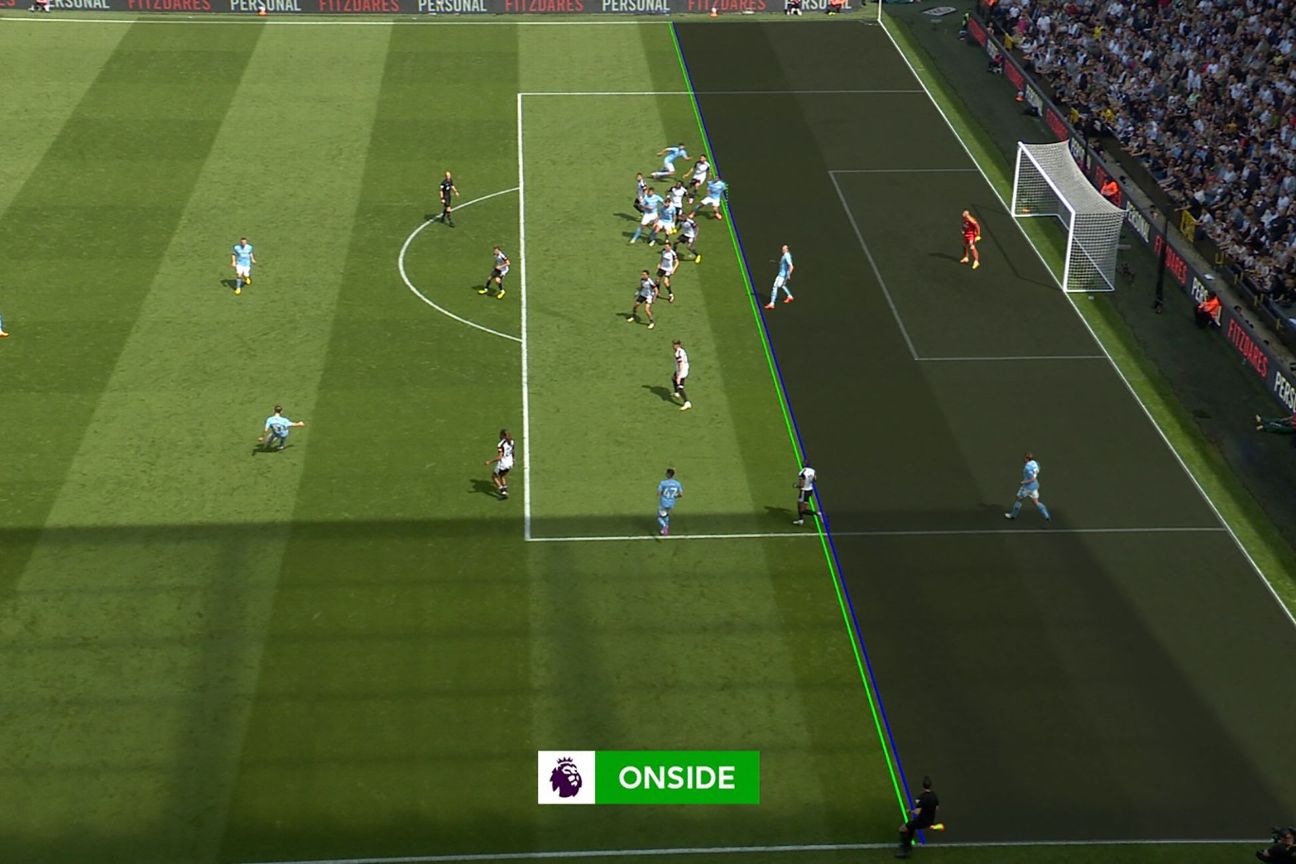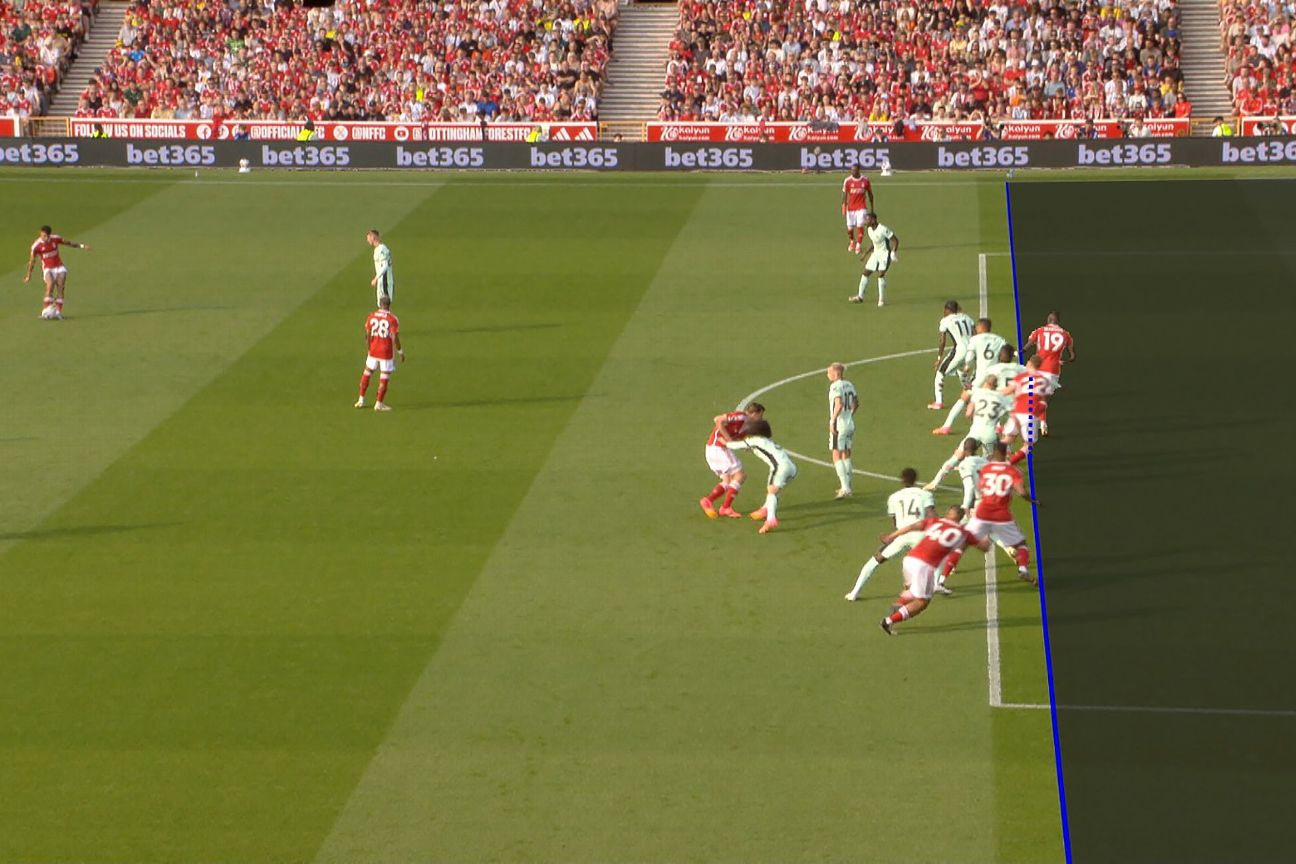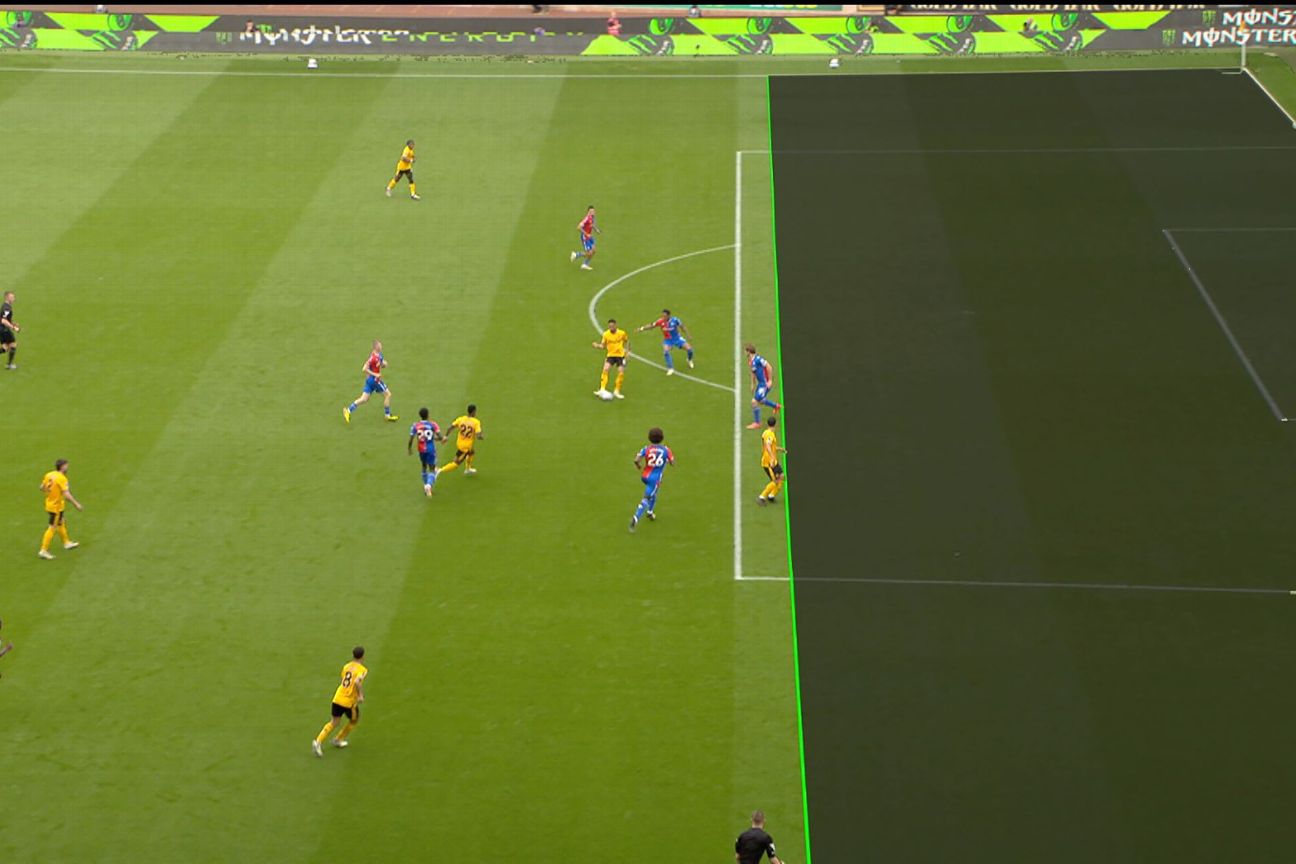Products You May Like
Video Assistant Referee causes controversy every week in the Premier League, but how are decisions made, and are they correct?
After each weekend we take a look at the major incidents, to examine and explain the process both in terms of VAR protocol and the Laws of the Game.
– How VAR decisions have affected every Prem club in 2023-24
– VAR in the Premier League: Ultimate guide
In this week’s VAR Review: Should Manchester United have been given a penalty against Arsenal? Did the VAR get the decisions correct which went against AFC Bournemouth and Brentford? Plus all the other big incidents.
Possible penalty: Challenge by Partey on Amad
What happened: Manchester United were on the attack in the 37th minute when Amad took the ball to the edge of the area. Thomas Partey made a sliding challenge and stretched out a leg, with the Man United forward then colliding with Gabriel and going to ground. Referee Paul Tierney wasn’t interested in a penalty, with Amad staying down until the ball was put out of play. The VAR, John Brooks, checked for a possible penalty.
VAR decision: No penalty.
VAR review: At first glance it seemed like this was very similar to the penalty awarded to Arsenal against Bournemouth last weekend, when Kai Havertz accepted the contact from the outstretched leg of Mark Travers when the goalkeeper came rushing out.
Except in this situation, there was one crucial difference: Partey got his toe to the ball, and then Amad stood on his leg; Amad then knocks into Gabriel and goes down. Without the touch on the ball there would have been grounds for a penalty, just as there were with Havertz, but it would still have to be given on the field rather than through VAR.
The Premier League’s Independent Key Match Incidents Panel ruled on a split 3-2 vote that the Havertz penalty was the correct decision on-field, and was unanimous that the VAR was right not to get involved to overturn it. The panel also said it was correct that Bournemouth’s goal was disallowed last weekend, as was the yellow card for Ryan Christie‘s challenge on Bukayo Saka.
Possible offside: Akanji on Gvardiol goal
What happened: Josko Gvardiol scored Man City’s third goal in the 71st minute when he fired home at the far post from a Bernardo Silva delivery. However, Manuel Akanji appeared to try to play the ball as it came across and the VAR, David Coote, checked for a possible offside.
VAR decision: Goal stands.
VAR review: Luckily for Gvardiol, Akanji was being played onside by Adama Traoré, who was slow getting out following the original corner move.
The VAR going through the process of applying the lines shows that Akanji had been deemed to be interfering, but there’s no offence once he’s shown onside.

Akanji attempted to kick the ball, which must have an impact on the decision making of Fulham goalkeeper Bernd Leno, who could have opted to close the space on Gvardiol much earlier if he didn’t have to consider the actions of Akanji.
In a remarkable coincidence, Man City should have had a goal disallowed in the home game against Fulham in September when Akanji made a movement to kick or avoid a header on goal from Nathan Aké. It was a VAR error not to tell the referee that goal should be ruled out. It was 1-1 at the time, and Man City went on to win 5-1.
Possible penalty overturn: Diop foul on Álvarez
What happened: Manchester City were awarded a penalty five minutes into added time when Julián Álvarez went down under a challenge from Issa Diop. Referee Anthony Taylor pointed to the spot, with the Fulham player sent off for a second bookable offence. The VAR checked the spot kick.
VAR decision: Penalty stands, scored by Álvarez.
VAR review: Last weekend we saw a poor on-field decision when Man City were awarded their first penalty against Wolverhampton Wanderers. The Independent Panel said on a split 3-2 vote that it shouldn’t have been given by referee Craig Pawson, but were unanimous that it didn’t reach the threshold for a VAR review.
That came when Rayan Aït-Nouri challenged Gvardiol after the Man City player had released his shot. That’s rarely penalised, and in fact it usually requires a reckless challenge for a penalty to be given — Aït-Nouri collided with Gvardiol more than there being any possible foul.
Diop’s challenge gives us the perfect example of when it should be a foul. Álvarez saw his shot blocked by Calvin Bassey with the striker than caught by a late tackle from Diop, which took him out after the ball had gone. It was reckless, and worthy of a yellow card.
Last weekend saw no VAR errors recorded in a weekend when there were several contentious incidents, but the panel did say that along with the City spot kick, Burnley should have been awarded a penalty on the field (but not through VAR) against Newcastle United for Bruno Guimarães‘ challenge on Lorenz Assignon.
Possible offside: Boly when scoring
What happened: Willy Boly equalised for Nottingham Forest in the 16th minute when he ghosted in at the back post to head home a free kick from Morgan Gibbs-White. The VAR began a check for offside.
VAR decision: Goal stands.
VAR review: The VAR determined this was a clear onside, therefore choosing to only display a single blue line rather than for both attacker and defender. It would have been clearer to display both because from the image, it looks like Boly’s foot is touching the line when it is in the air, meaning it would further back at ground level.

Boly was played onside by the outstretched arm of Benoît Badiashile and may also have been saved by the Premier League using the badge on the arm to try to achieve a consistent application with the offside technology.
Next season, semi-automated VAR offside (SAOT) will pinpoint the position on the arm more precisely, which will be higher and more towards the shoulder. That would bring the offside line further up the pitch and, with there being no tolerance level in SAOT, Boly may well have seen this goal ruled out.
Wolves also benefitted from the tolerance level for their goal for Matheus Cunha against Crystal Palace. A single green line is displayed on the graphic, which tells us it was very close — and probably offside with SAOT.

Possible penalty: Aina challenge on Jackson
What happened: Chelsea had a corner in the 44th minute and just as the ball had been kicked Nicolas Jackson went down in a tussle with Ola Aina. It would have been difficult for referee Tony Harrington to see, and was checked by the VAR, John Brooks.
VAR decision: No penalty.
VAR review: The ball was in play when the incident happened, which mean the VAR could have given the spot kick — the only thing that could have saved Aina is the way the Chelsea player appears to throw himself down.
It brings us back to the regular question of when grappling in the penalty area crosses the line from normal football contact to a foul. Last weekend we saw one of the more obvious examples, when Everton‘s Jarrad Branthwaite was held by Luton Town defender Teden Mengi.
Possible disallowed goal: Handball by Semenyo before Solanke goal
What happened: Dominic Solanke thought he had given Bournemouth the lead in the 26th minute after he had been put through on goal by Antoine Semenyo. However, Brentford players had appealed for handball when Semenyo gained control of the ball and it was checked by the VAR, Chris Kavanagh.
VAR decision: Goal disallowed.
VAR review: Semenyo wasn’t the goal scorer so it needs to be a deliberate movement of the arm for the VAR to rule the goal out for handball in the buildup.
It’s a situation that is completely open to interpretation. Did Semenyo move his arm towards the ball, or was it part of his running action? You can argue both sides, and there have been several times when the ball has hit the arm of the player who has created the goal and it’s been deemed accidental.
As Semenyo then created the goal it would be considered part of the same attacking phase of play.
If you’re a Bournemouth fan you want the goal, while everyone attached to Brentford will say it’s a clear handball.
Possible goal: Foul by Solanke on Collins
What happened: A long ball was played forward by Lewis Cook in the 36th minute, looking for Dango Ouattara. It was cut out by Kristoffer Ajer, with the ball dropping to Brentford teammate Nathan Collins. The defender went to ground when challenged by Solanke, with referee Matthew Donohue blowing his whistle for a foul just as the striker hit a shot that went into the goal.
VAR decision: No review possible.
VAR review: A lesson in VAR for Donohue, who was taking charge of his first-ever game in the Premier League. A wiser referee would have held the whistle for just a couple of seconds to see what happened in the attacking phase, because as soon as Donohue blows the play is dead and the VAR cannot review it.
Last weekend referee David Coote did exactly this before awarding the foul by Solanke on Arsenal goalkeeper David Raya before Semenyo scored. The VAR didn’t advise the referee he’d made a mistake, but at least there was the opportunity to look at it.
That said, while this was a soft free kick it’s unlikely the VAR would have told the referee it was a clear and obvious error to give the foul. Brentford goalkeeper Mark Flekken didn’t make an attempt at the save due to the whistle, so it would be a stretch to say the home side were denied a goal.
Possible penalty overturn: Foul by Zabarnyi on Toney
What happened: Brentford were awarded a penalty in the 72nd minute when Yoane Wissa broke and squared a pass for Ivan Toney, who went to ground under a challenge from Illia Zabarnyi. Referee Donohue pointed to the spot, and it was checked by the VAR.
VAR decision: Penalty cancelled.
VAR review: Perhaps this is another example of a VAR learning from past examples, though it’s difficult to see the line of consistency on when a soft penalty is overturned on review. Fans may feel there’s been many similar spot kicks not overturned on review.
The VAR chose not to get involved to overturn Chelsea’s penalty against Burnley in March, which led to Lorenz Assignon receiving a second yellow card. There was minimal contact on Mykhailo Mudryk from Assignon, and in this case Zabarnyi didn’t appear to make any kind of challenge.
Zabarnyi has one hand on the back of Toney, but there doesn’t seem to be a push, and the striker stretches his right leg across the Bournemouth defender to initiate the contact.
Newcastle forward Anthony Gordon has proved himself adept at getting in front of a defender and accepting contact to win spot kicks, but Toney’s actions were too obvious in trying to win the penalty.
Gordon tried to get a penalty in a similar way to Toney this weekend, placing his right leg in front of Brighton & Hove Albion defender Tariq Lamptey. Referee Darren England waved play on and that decision was supported by the VAR.
Possible red card: Robinson on Calvert-Lewin
What happened: Jack Robinson was booked in the 36th minute for pushing Dominic Calvert-Lewin to the ground, but Everton manager Sean Dyche seemed shocked that the Sheffield United player wasn’t sent off. The VAR, Graham Scott, checked the incident.
VAR decision: No red card.
VAR review: Robinson’s actions were worthy of a yellow card, as he pushed Calvert-Lewin over in an off-the-ball incident.
Yet a red card from referee Stuart Attwell would be extremely harsh for a push to the chest.
Some factual parts of this article include information provided by the Premier League and PGMOL.
